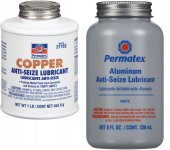BajaRon
Well-known member
As always, thanks Ron. I'm glad you wrote this, as I was under the impression that people used the anti-seize red stuff everywhere, including the back of the backing plate, (between the plate fuzed to the pad, and the removeable clip that clips to the plate, right?)
I will get both anti-seize and some Brake Quiet stuff.
This sounds like a good winter project in a few months, but I'm guessing I have at least six more easily on these. The backs are both at least 3mm thick. (I don't know how you guys check them on the ground.)
I'll also do your "brake seating" procedure after I get them replaced.
No, don't put anti-seize on the backing plate. These are the anti-seize products I use. Both work well and for the average person, will last a very long time. Any quality product will do you well.

